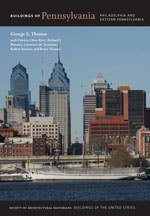
The American countryside was once dotted with communities that offered escape from summer heat and urban temptation in a rural setting that recalled the origins of their religious community. Like Oak Bluffs on Martha's Vineyard and New Jersey's Ocean Grove, this Methodist camp meeting is organized around shared open spaces that are focused on settings for religious services. Community identity is asserted by the tiny streets that are named for the founders and promulgators of the denomination, Francis Asbury, John Wesley, and so on. Most remarkable is the open auditorium stage, called the “Tabernacle,” that faces a lawn for seating. Its pilastered facade and shallow pediment recall the porches of the Stockton Hotel in Cape May, designed by Stephen Button, and suggest connections to the recreation architecture of the period. An octagonal open pavilion for youth services built in 1909 to replace an earlier structure is the center of a second open space. Both greens are framed by tiny wooden Victorian cottages, some little more than a single room and no larger than a boxcar. Embellished with front porches and bits of scroll-sawn ornament, they offered the row-housed masses their chance at the rising suburban aesthetic and contemporary taste.














